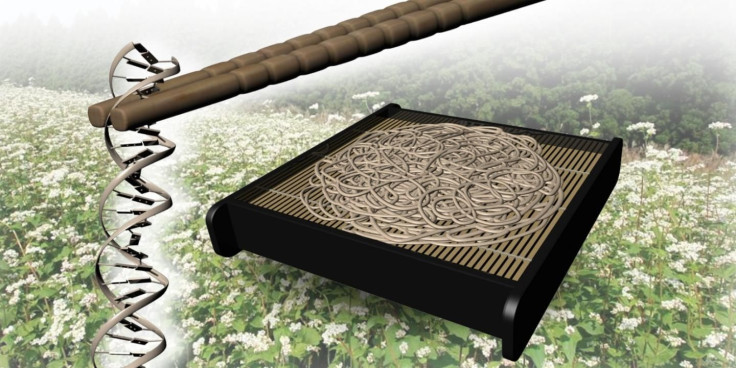These Lab-Engineered Japanese Noodles May Be The Perfect Gluten-Free Option

Gluten-free options are available in virtually all grocery stores and in many restaurants to meet the demand of the many Americans going gluten-free. Researchers from Kyoto University in Japan took the first steps to creating a better gluten-free option for pasta, pancakes, and other favorites. Using genome sequencing, researchers took the traditional Japanese soba noodle’s main ingredient — buckwheat — and identified genes to improve its taste and appeal for consumers worldwide.
"Genome data is essential to make crops better suited for our needs, but until now data on the knotweed family of plants, including buckwheat, were not available," said the study’s lead author Yasup Yasui, a researcher at Kyoto University, in a statement. "In our study we sequenced the entire genome and created a Buckwheat Genome DataBase, which is now available publicly from the Kazusa DNA Research Institute."
For the study, published in DNA Research, the team identified the specific genes in buckwheat that give it an undesirable “mochi” texture, which is described as a soft, chewy texture. Next, they looked for genes that make buckwheat turn a darker and unappetizing color. If researchers can manipulate the genome sequence by turning off these genes, they could design a noodle with an improved texture and appearance for an international consumer.

Buckwheat is neither a grain nor is it related to wheat, which makes it a realistic gluten-free and safe option for those with celiac disease (autoimmune disorder that causes a severe intolerance for gluten) and gluten sensitivities. Gluten is a protein found in wheat that’s responsible for creating the elastic texture of dough — think of it as the glue that holds the pasta or bread together. Buckwheat functions like gluten, but it’s not a grain. It’s actually a fruit seed that has been increasingly replacing white flour in gluten-free products in America.
Besides effectively replacing gluten, buckwheat is also packed with health benefits, including heart-healthy fiber and protein to keep you fuller longer. It contains eight essential amino acids, which make it a complex protein that meets the nutritional needs of vegetarians, and additionally fatigue-fighting iron, bone-building calcium, along with magnesium, copper, zinc, and omega-3s. It seems like the perfect substitute for those trying to avoid gluten products. However, buckwheat has a few flaws that may make some gluten-free consumers shy away.
"Scientists have so far succeeded in getting the distinctive 'mochi' texture out of wheat, but that hadn't been accomplished yet with buckwheat," Yasui said. "Since we've found the genes that could give buckwheat this texture, I think we can hope to see foods — including soba noodles and doughy European foods — with radical new sensations appearing on the market in the near future."
Unfortunately, buckwheat contains allergens that trigger severe reactions in some people, which is why searching for the genes that are responsible for causing allergies may make or break the soba noodle’s success in America and other countries.
"Buckwheat flour can replace wheat flour in a gluten-free diet,” Yasui said. “One of our next goals is to make buckwheat less allergenic so that buckwheat-based foods become an option for more people."
Source: Yasui Y, et al. Assembly of the draft genome of buckwheat and its applications in identifying agronomically useful genes . DNA Research . 2016.



























